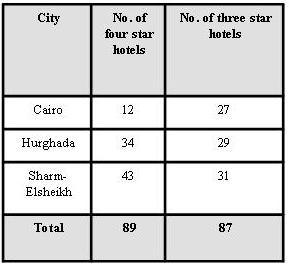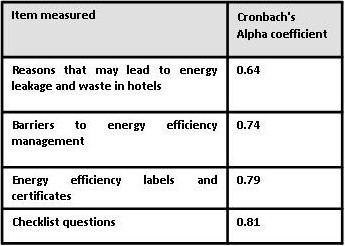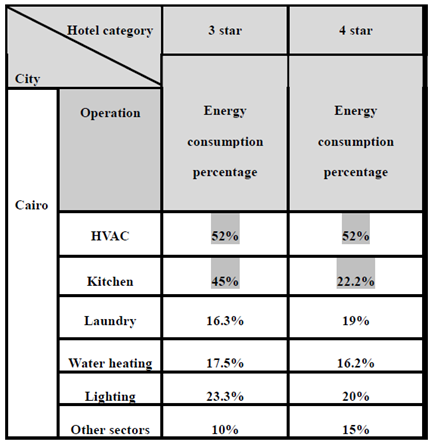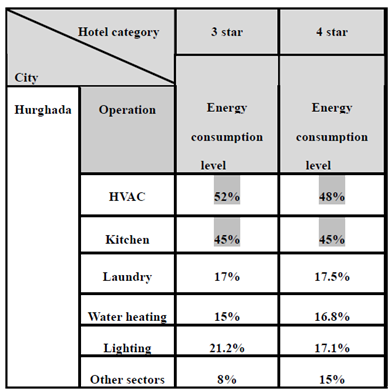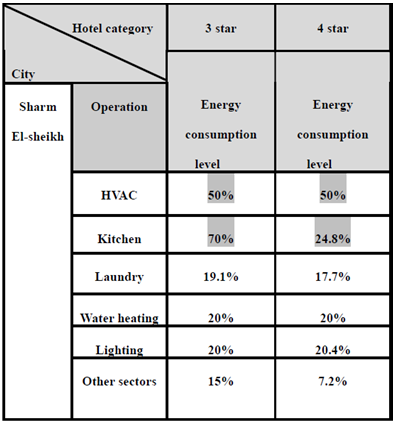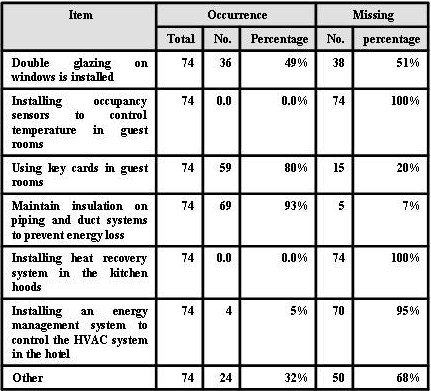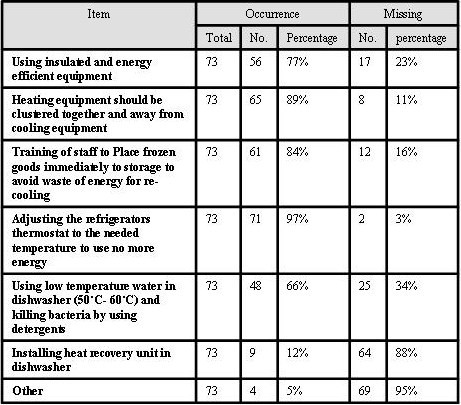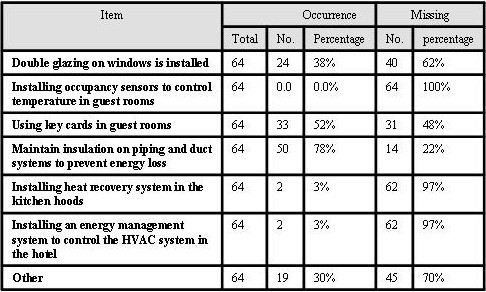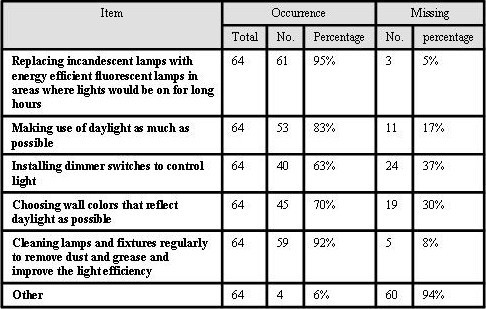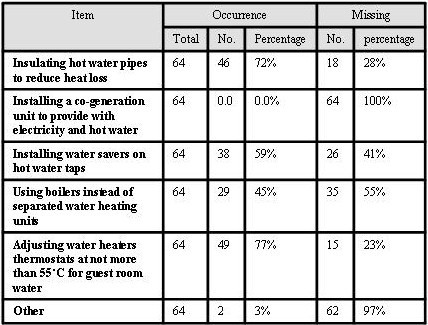-
Paper Information
- Next Paper
- Paper Submission
-
Journal Information
- About This Journal
- Editorial Board
- Current Issue
- Archive
- Author Guidelines
- Contact Us
American Journal of Tourism Management
2012; 1(2): 21-34
doi: 10.5923/j.tourism.20120102.01
The Management of Energy Leakage and Waste in Three and Four Star Hotels
Saad B. A , M. M. Hewedi , Ashraf Elsayed Abdel - Maboud
Hotel Studies Department, Faculty of Tourism and Hotels, Fayoum University, Fayoum, P.O.Box 63514, Egypt
Correspondence to: Saad B. A , Hotel Studies Department, Faculty of Tourism and Hotels, Fayoum University, Fayoum, P.O.Box 63514, Egypt.
| Email: |  |
Copyright © 2012 Scientific & Academic Publishing. All Rights Reserved.
This paper aims to investigate the dimensions of the energy leakage and waste problem in three and four star hotels in Egypt. A questionnaire form and a checklist were designed and distributed to the 176 chief engineers in three and four star hotels in Cairo, Hurghada and Sharm-Elsheikh. The findings of the study showed that fossil fuels are the main sources for generating energy at three and four star hotels and the forms used are in a descending order, Electricity, Diesel oil, Liquefied petroleum gas, natural gas. The results clearly elucidated that only 39 of the investigated 176 three and four star hotels use solar energy for water heating only. The results showed that the HVAC systems consume more electricity and followed by the kitchen compared to other sectors. 80% of the respondents in the four star hotels and 67% in the three star hotels agree that staff wrong practices in using equipment and devices is the main cause that may lead to energy waste in their hotels. It is quite clear that there are several barriers that hinder improving and developing efficient system to reduce and manage energy leakage among which; shortage of financial resources, lack of technical services and skilled labor force. Loose legislations and ill staff practices in using equipment and devices are among other reasons. The entire population of the study is only interested in investing no, low and medium cost to minimize energy leakage. It was found also that only 5 hotels of the four star category that comply with the ISO 14001 certificate standards and the Green planet label. The current research concluded the indigence need to raise the level of hoteliers' awareness of the potential using of renewable energy. There is also essential to build up policy based on implementing feasible energy management program. Also benefiting from organic waste in the hotels by installing a station to gather and ferment the waste to produce methane gas to use it as a cooking fuel.
Keywords: Energy Leakage and Waste, Energy Management Program, Environmental Quality System
Cite this paper: Saad B. A , M. M. Hewedi , Ashraf Elsayed Abdel - Maboud , "The Management of Energy Leakage and Waste in Three and Four Star Hotels", American Journal of Tourism Management, Vol. 1 No. 2, 2012, pp. 21-34. doi: 10.5923/j.tourism.20120102.01.
Article Outline
1. Introduction
- Energy resources as one of the assets of a hotel need from the manager to decide how best to use them to achieve the organization's objective. Especially nowadays as several studies such as[1],[2], and[3] indicated that the increasing prices of energy resources and growing pressure from governments and stakeholders provided increased motivation to lodging operators to enhance energy efficiency in their properties. With regard to the hotel industry as one of the major sectors of the hospitality industry, they need a base load of energy that forms a fixed cost to operate equipment such as heating, ventilation, cooling and lighting regardless of the number of guests staying at the hotel, in addition some studies like[4] and[5] indicated that hotels rank among the top five in terms of energy consumption in the commercial building sector.Reference[6] differentiated between two types of losses of energy in the hospitality establishments, the first is energy waste that could happen due to turning on equipment on far in advance of its need to be used and being left on even though it is no longer needed i.e. air-condition and dishwasher or using it in half of its load i.e. ranges. The second is energy leakage due to poor insulation i.e. in hot water pipes. By considering these concepts,[7] stated that the cooking equipment and HVAC systems are the most wasters of energy as about 50% of the energy used to heat food is wasted and not properly maintained cooling system can require 10% more energy. According to some field studies conducted by[8] to assess the potential energy efficiency and measures in 3 and 4 star hotels it was found that all the investigated hotels still use normal incandescent bulbs that use more energy, there is no insulation for the hot water system and that could lead to waste of energy and the air-condition system is operated with On/Off control which means that the air-condition could work even if there is no guest in the room and consequently wastes energy.In the studies of[9],[10], and[3], they revealed the aspects of energy leakage and waste in hotels and attributed them to lack of awareness of operators and engineers of the energy saving opportunities and concentration only on energy expenditure without attention to the specific consumption of energy of the different sectors in hotels. Therefore hotels need to apply energy management program that minimize wastes and improve proper practices. Such approach has been effectively implemented after OPEC oil embargo in 1973 as it was previously reported in the study of[11] and[7], who indicated that hotels started to show an immediate response to conserve and manage energy and consequently add a new dimension to the job of the chief engineer to make a significant savings of energy. In this respect,[12] as well indicated that the estimate of the percentage of energy saving that could be achieved by the application of energy efficiency improvement technologies especially in lighting, heating, ventilation and air-conditioning systems has ranged from 5% to 15% in Egyptian hotels.It can be clear that there is a national benefit from energy conservation in hotels through saving capital investments needed for energy projects and reducing harmful emissions. Hotel management and guests also can benefit through increasing guest satisfaction at a lower cost, running the hotel efficiently and making reduction of the use of non-renewable energy resources. Although there is a great progress in the renewable energy technology applications like solar energy for water heating and cooking, wind energy for generating electricity, geothermal energy for warming and water heating and modern cooking equipment and systems that could save energy and conserve the environment,[13] referred to that the medium and small hotels are unlikely to achieve large savings of energy compared with large hotels which can undertake capital investments. Therefore the current study concentrates on identifying the aspects of the energy leakage and waste problem in three and four star hotels in Egypt.
2. Methodology
- A questionnaire form was designed and distributed to the chief engineers in three and four star hotels. The questionnaire used for this study consists of nine questions dealing with the level of chief engineers' awareness of the energy leakage and waste management concept, identifying the causes of energy leakage and waste, ascertaining the barriers that hinder energy efficiency improvements in three and four star hotels, the levels of energy consumption of the different sectors and the extent of using renewable energy and the extent of complying with environmental quality systems related to energy usage efficiency. The sequence of the questions was arranged in five groups as follows: 1- Group one is a multiple choices question to inquire about the sources of energy used in the hotel.2- Group two includes a question to identify the level and percentage of energy consumption per different hotel sector. 3- Group three includes three questions were developed to inquire about the awareness of chief engineers to the energy leakage and waste management concept and the application of an energy management program, where the first question is a yes or no filter question to inquire about the awareness of respondents to the energy leakage and waste management concept, the second question is an open-ended multiple choices question to inquire about how the management of energy leakage and waste concept is applied in the hotel, the third question is a yes or no supplemental question to ask if the hotel implement an energy management program. 4- Group four includes two questions where the first question is an open-ended multiple choices question to ask the respondents about their opinions about the causes that may lead to energy leakage and waste in their hotels and the second question is a likert scale type question with a 1 to 5 rating where (1=strongly agree and 5= strongly disagree) to ask about the barriers of energy efficiency improvement in the investigated hotels. 5- Group five includes two questions where the first question is a yes or no filter question and the second question is a likert scale type question with a 1 to 5 rating where (1=strongly agree and 5= strongly disagree) to ask about the affiliation with energy efficiency labels and quality systems in the investigated hotels.Field visits were conducted using a checklist to investigate the energy practices applied in the hotels, in addition to help interpreting the results of the survey.The checklist consists of five groups of multiple choice questions to inquire about the practices applied in the main energy end-users in the hotel that include HVAC systems, lighting, kitchen, laundry and water heating.
3. Sample
3.1. Sampling frame
- The frame of this study includes the three and four star hotels in Cairo, Hurghada and Sharm-Elsheikh as they represent about 51% and 66% respectively of the total number of the three and four star hotels in Egypt and the biggest number of hotel capacity according to[14].
3.2. Stratification
|
3.3. Pre-testing and Pilot Study
- A sample of 25 questionnaire forms and checklist were pre-tested by academics and industry experts to validate and assume their appropriateness to the purpose by all respondents, according to[15]. The pre-testing resulted in many modifications in questions wording and sequence. In addition, the reliability coefficient (Cronbach's Alpha) was calculated to measure the internal consistency of the questionnaire and checklist as shown below.
|
4. Findings
4.1. Reliability Analysis by Using Cronbach's Alpha Coefficient
- As shown in (table 2), the computed Cronbach's Alpha coefficient values for questions in 25 questionnaire forms and checklists in the pilot study are 0.64, 0.74, 0.79 and 0.81 respectively and they are acceptable measures for the reliability of the questionnaire and the checklist questions according to[16].
4.2. Energy sources used in three and four star hotels
- The results obtained clearly indicated that 59.3% and 60.8% of the three and four star hotels respectively use gas (liquefied petroleum gas, LPG) mainly for cooking and it was observed that it is used for water heating in one hotel in Sharm El-sheikh. The respondents stated that gas is cheaper and has superior burning efficiency. This finding agrees with the result of[17], who found that most of the hotels visited use LPG for cooking for the similar reasons. On the other hand, poor transportation access, unsafe storage of gas and supply in winter represent a major problem that hinder using gas by 7% and 19% of three and four star hotels respectively. The results indicated that 67.2% of the three star hotels and 81.1% of the four star hotels use diesel oil for water heating in the boiler and in emergency electricity generators, thus the diesel oil is widely used and that could be due to its cheapness and burning efficiency compared with electricity for water heating. In spite of that[18] stated that the cost of thermal energy is directly tied to fuel costs and the diesel oil as a fossil fuel has a significant environmental impact resulting from burning it. Therefore the hotels need a system to use this source efficiently without waste, this can be done through using of a combined heat and power unit that generates electricity and provide hot water according to[19] and[20].
 | Figure 1. The profile of energy resources and their usage in 3 and 4 star hotels |
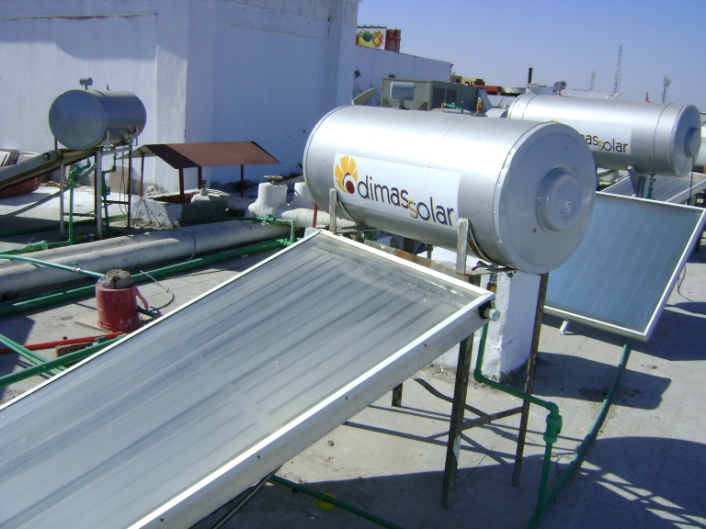 | Figure 2. Solar water heater at one of the investigated four star hotels in Hurghada |
4.3. The consumption of energy by the different operations in the hotels of the current investigation in a descending order of follow
|
|
|
4.4. Following a Uniformed Energy Leakage and Waste Management Program in the Hotel
- "Energy management includes all practices, measures and actions that aim to minimize energy waste"[27]; without adversely affecting the building's functional requirements. It is a multidimensions system[28] and[29] that covers developing an energy efficient culture, understanding and controlling the energy usage. In this respect the results of the current study have shown that most of respondents lack the awareness and knowledge of their hotels energy management policy. However, they mostly aware of necessary energy saving practices.Although, there are 13 of 57 of the respondents in the three star hotels and 22 of 70 of the respondents in the four star hotels showed that they have an energy management program and indicated that they interpret the full concept of energy leakage and waste management.
4.5. Energy Leakage and Waste in Three and Four Star Hotels
- Energy leakage and waste is quite remarkable in 3 and 4 star hotels due to different reasons as shown in (table 4). The ranking cause differs between two hotel categories except that staff poor practices in using equipment and devices occupied the top rank and using of low energy efficiency equipment came into the 7th rank for both hotel categories. Surprisingly enough that poor insulation of piping and duct systems was remarkable and highly ranked by the researcher, it came at the 9th ascending order cause of energy leakage and waste. Other causes ranked 3-6 categories for both 3 and 4 star hotels.In similar studies[30],[31],[32] and[33] identified staff attitude problems, inadequate maintenance or personnel, poor design and insulation and uncomfortable work conditions as main causes of energy leakage and waste but they did not provide a particular arrangement for these causes.
4.6. Barriers to Energy Efficiency Improvement in the four Star Hotels
- Figure (3) shows that high proportion of respondents (39.4% agree and 29.6% strongly agree) view that high cost and lack of financial resources as the limiting factor that hinder improving the efficiency of energy management. Similar findings were reported by[34] and[35]. The results also showed that (19.7% strongly agree and 21% agree) that lack of loans or economic subsidy provided by the government to increase energy efficiency is another barrier to improving energy efficiency. On the other hand,[18] reported contradicted view based on the abusing of the energy subsidy policy prices that lead to higher energy wastes. It could be noticed also that hotels could have loans from banks in addition to their flow of fund to finance their energy efficiency projects therefore the former results did not clarify exactly if it is really a barrier or not.
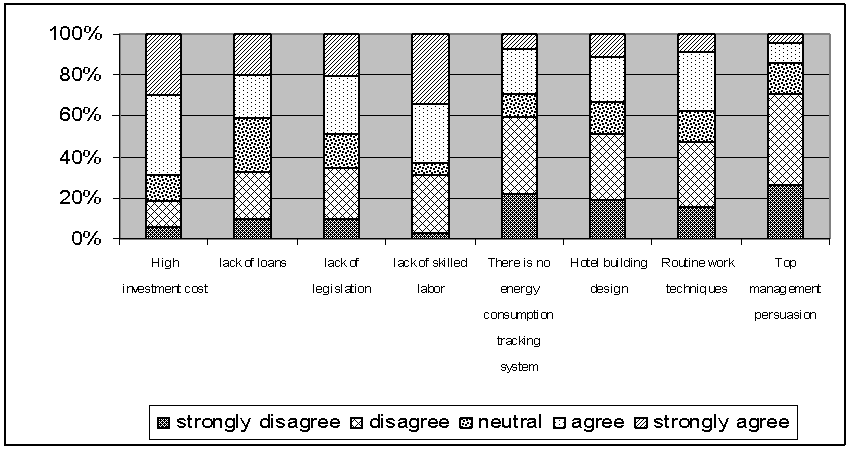 | Figure 3. Frequencies of energy efficiency improvement barriers in the three star hotels |
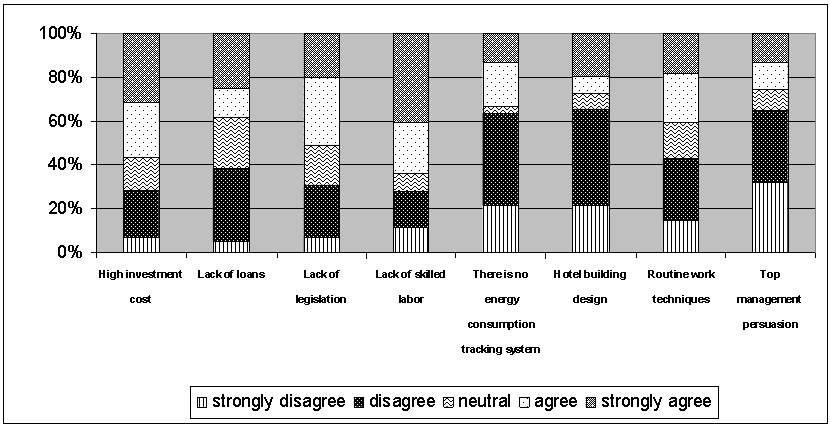 | Figure 4. Frequencies of energy efficiency improvement barriers in the three star hotels |
4.7. Barriers to Energy Efficiency Improvement in the Three Star Hotels
- Figure (4) shows that high proportion of respondents (31.7%strongly agree and 25% agree) that high cost of investment is a limiting factor that hinder improving energy in three star hotels, while only 6.7% of the respondents strongly disagree, 21.7% disagree and 15% are neutral. This result is in accordance with the former result in the four star hotels in that high cost and lack of availability of financial resources is a barrier to energy efficiency improvements.The results showed that high proportion of respondents (20.3% strongly agree and 30.5% agree) that lack of legislation related to energy efficiency improvement in the three star hotels is a barrier as there is no definite law to organize energy usage and consumption in hotels. On the other hand a portion of respondents (6.8%) strongly disagree, 23.7% disagree and the rest (18.6%) are neutral. This result is in accordance with the former result in the four star hotels and what was reported by[18] as lack or weak legislation related to using energy resources hinder the activation of energy efficiency improvement in the hotels.According to the survey results, 25% of the respondents strongly agree and 13.3% agree that lack of loans or economic subsidy provide by the government is a barrier to energy efficiency improvement in three star hotels whereas only 5% strongly disagree, 33.3% disagree and 23.3% are neutral. Hence it is clear that lack of loans or economic incentive systems from the government to enhance energy efficiency in the three star hotels is not a barrier as the total response of both agreement and disagreement is the same (38.3%) while 23.3% are neutral. This result is in accordance with the previous result in the four star hotels and that could be due to the possibility of taking up loans from banks to finance energy efficiency improvement projects in hotels regardless the oriented subsidy from the government to the energy resources. This result is not in accordance with what previously indicated by[18].The results showed that the majority of respondents (41% strongly agree and 23% agree) that lack of skilled labor who are capable of maintaining new technological equipment is a barrier to energy efficiency improvement in the three star hotels. Whereas only 11.5% strongly disagree, 16.4% disagree and 8.2% are neutral. Thus, it could be clear that lack of skilled labor is a barrier to energy efficiency improvement in the three star hotels. This result is the same as in the four star hotels. Reference[35] as well indicated that lack of knowledge of the staff is a barrier to improve energy efficiency of buildings.It was found also that high proportion of respondents (21.7%strongly disagree and 41.7% disagree) that they do not have any system for energy consumption tracking and therefore it is a barrier to energy efficiency improvement in the three star hotels. While 13.3% strongly agree, 20% agree and only 3.3% are neutral. This result is in accordance with the former result of the four star hotels in that most of the hotels make readings of energy consumption regularly and consequently it is not a barrier. On the contrary,[32] stated that little or no tracking of energy consumption is one of the main causes of energy problems in hotels.The results indicated that 21.3% strongly disagree and 44.3% disagree that hotel building design is a barrier to energy efficiency improvement in the three star hotels, while only 19.7% strongly agree, 8.2% agree and 6.6% are neutral. This result is in accordance with the former result of the four star hotels in that hotel design is not a barrier to enhance energy use efficiency. This can be due to that respondents think that they can accommodate their operation to the hotel design without wasting energy. This result does not conform to what was previously stated by[33], who viewed that inefficient designed hotels could waste energy.In addition, 18% of the respondents strongly agree and 23% agree that routine approach to perform work is a barrier to energy efficiency improvement in the three star hotels, whereas 14.8% strongly disagree and 27.9% disagree and 16.4% are neutral. Therefore it is clear that monotonous approach of work may be a barrier to some hotels and reversely for the other as the percentage of agreement and disagreement is close to an extent. This result differ from the result in the four star hotels where routine work methods is not a barrier to energy efficiency and this can be due to that there are many routine procedures of work that the hotels could not dispense with it. In this respect,[36] reported that many buildings are wasting energy because of neglected operation.Other results showed that 32.3% of the respondents strongly disagree and 32.3% disagree that no conviction of the top management that energy efficiency technologies are worthwhile is a barrier to energy efficiency improvement in the three star hotels. On the other hand, 12.9% strongly agree, 12.9% agree and 9.7% are neutral. Therefore it could be clear that this result is in accordance with the result in the four star hotels in that the conviction extent of the top management is not a barrier to energy efficiency improvement. On the contrary,[31] indicated that the top management negligence is a cause of energy waste and consequently hinder the commitment of energy efficiency improvement.
4.8. The Affiliation with Eco-labels Systems Related to Energy Efficiency in the Four Star Hotels
- The results obtained of the frequencies indicated that there is lack of affiliation with energy efficiency labels in the four star hotels as there is only 5 hotels from the total 74 sharing hotels have the Green Planet award and the ISO 14001 certificate. And that can be due to lack of information about energy efficiency labels and how the hotel can comply with its standards. Similar result was previously stated by[1], who indicated that eco-friendliness ranks low in hotels due to lack of customer interest in addition to other economic, political and socio-cultural factors of a country. Reference[37] attributed the lack of affiliation with energy efficiency labels to hotels that are less influenced by stakeholders such as customers, suppliers and local authorities who are interested in the hotel environmental performance. On the other hand, there is no hotel of the total sharing 64 three star hotels has any energy efficiency label. This result is similar to an extent to the results of the four star hotels as there is lack of affiliation with eco-labels and that can be due to lack of information about energy efficiency labels and uninteresting to comply with their standards.
4.9. Checklist Analysis in the Four Star Hotels
4.9.1. Heating, Ventilation and Air-conditioning Practices
- The statements used to assess the efficiency of heating; ventilation and air-conditioning practices in the four star hotels and rate of their application are shown in (table 6).It was observed that the four star hotels tend to traditional low to medium cost practices to reduce energy leakage and waste as 93% of the hotels maintain insulation on pipes and ducts, 80% use key card (power saver card) and 49% of hotels fix double glazing on windows to prevent heat loss or gain while all of them do not use occupancy sensors in guest rooms or heat recovery system in the kitchen hood because of their high cost and unavailability, On the other hand 32% of hotels use other actions like control timers or thermostat in the air-condition and 5% use an energy management system to control air-condition. Similar result was previously stated by[38] and[35],who indicated that high capital cost and lack of awareness to some systems are the main barriers to tending to high cost actions. Although[6] indicated that low to medium cost actions to reduce energy leakage and waste lead to noticeable results. Reference[39] reported that installing heat recovery system can reduce energy waste by 10% to 25%. Reference[40] as well indicated that using occupancy sensors can save 2 to 3 billion kilowatt-hours annually in the U.S hotels.
|
4.9.2. Lighting Practices
- The Statements used to assess the efficiency of lighting practices in the four star hotels and rate of their application are shown in (table 7).The obtained results showed that the four star hotels tend to low or medium cost actions side by side with high cost actions as 93% of the four star hotels subject to the investigation use energy saving fluorescent lamps instead of incandescent lamps, 92% clean lighting fixture regularly, 81% can make use of day light, the wall color that reflects light is used by 77% of the hotels, 73% use dimmers to control light and 12% use other actions such as using timers and photo cell lighting. This result can be due to that the cost of actions related to reduce energy waste in lighting is low compared with other actions. Reference[40] stated that using compact fluorescent lamps can save about 2 to 3 billion of kilowatt-hours annually if used in 90% of the U.S hotels. Reference[41] as well reported that installing occupancy sensors or key card system in the guest room can result in great saving of energy.
|
4.9.3. Kitchen Operation Practices:
- The Statements used to assess the efficiency of kitchen operation practices in the four star hotels and rate of their application are shown in (table 8).
|
4.9.4. Laundry Practices
- Statements used to assess the efficiency of laundry operation practices in the four star hotels and rate of their application are shown in (table 9).
|
4.9.5. Water Heating Practices
- The Statements used to assess the efficiency of water heating practices in the four star hotels and rate of their application are shown in (table 10).The results obtained indicated that 92% of the total study hotel sample insulate hot water pipes to prevent heat leakage, 78% use a water boiler instead of electric water heaters, 69% install water savers on taps, 60% adjust water heaters thermostat to the fair degree of 55℃ and 7% follow other actions such as using solar water heaters whereas none of the hotels installed a combined heat and power unit (CHP) to provide with electricity and hot water. Therefore these hotels tend to low to medium cost actions to reduce energy leakage and waste in water heating operations and that can be due to lack of awareness of some systems or it is not viable in the hotel. However,[44] reported that the installation of a CHP unit in two hotels in England made savings of ₤3900/year and ₤5430/year. In addition[18] indicated that the adoption of a CHP unit in a hotel in Sharm-Elsheikh made savings of about 106319 pound/year.
|
4.10. Checklist Analysis in the three Star Hotels
4.10.1. Heating, ventilation and air-conditioning practices
- The Statements used to assess the efficiency of heating; ventilation and air-conditioning practices in the three star hotels and rate of their application are shown in (table 11).
|
4.10.2. Lighting Practices
- The Statements used to assess the efficiency of lighting practices in the three star hotels and rate of their application are shown in (table 12).
|
4.10.3. Kitchen Operation Practices
- The Statements used to assess the efficiency of kitchen operation practices in the three star hotels and rate of their application are shown in (table 13).The results obtained revealed that 91% of the three star hotels subject to the investigation adjust the refrigerators thermostat to the proper temperature to save energy, 83% cluster heating equipment away from cooling equipment in order to save energy, 81% train staff to store frozen foods immediately in order not to waste energy in refreezing, 73% use insulated kitchen equipment, 59% use hot water of 50℃ to 60℃ in dishwasher especially in the rinsing cycle, 11% use dishwasher with heat recovery unit and 6% follow other actions such as cleaning and maintenance of equipment. Therefore it is well clear that most of these practices fall in the no cost or medium cost practices as just 11% of the hotels use dishwasher with heat recovery system that costs more compared with other dishwashers. This result is also similar to the result in the four star hotels and can be due to lack of awareness of new systems that save energy and reduce leakage and waste. In the light of that,[45] and[46] referred to many energy efficient kitchen equipment such as combination steamer that can save 60% of energy compared with other equipment.
|
4.10.4. Laundry Practices
- The Statements used to assess the efficiency of laundry operation practices in the three star hotels and rate of their application are shown in (table 14).
|
4.10.5. Water Heating Practices
- The Statements used to assess the efficiency of water heating practices in the three star hotels and rate of their application are shown in (table 15).
|
5. Conclusions
- It was found that all the investigated three and four star hotels depend on traditional sources of energy generated from fossil fuels which are respectively according to usage, Electricity, Diesel oil, Liquefied petroleum gas (LPG),natural gas. On the other hand there are 39 of the investigated 176 three and four star hotels use solar energy only for water heating and they are respectively, 4 hotels of the three star category in Cairo, 14 hotels of the three star category and 9 of the four star category in Hurghada and 5 hotels of the three star category and 7 of the four star category in Sharm El-sheikh.HVAC systems have the highest mean of energy consumption percentage in three and four star hotels that is 52% in the three star hotels and 52.5% in the four star hotels in Cairo, 52.7% in the three star hotels and 47.5% in the four star hotels in Hurghada and 50% for both three and four star hotels in Sharm El-sheikh respectively and followed by the kitchen that is 45% in the three star hotels and 22.2% in the four star hotels in Cairo, 45% for both three and four star hotels in Hurghada and 70% in the three star hotels and 29.7%in the four star hotels in Sharm El-sheikh.The chief engineers are aware of different concepts of the energy leakage and waste management where 33.9% of the respondents in the three star hotels and 44.4% of the respondents in the four star hotels interpret the correct concept of energy leakage and waste management in their hotels, but their hotel programs to manage energy leakage and waste do not promote the energy management program in the full sense of word and depend mainly on some actions to save energy.80% of the respondents in the four star hotels and 67% in the three star hotels agree that wrong practices of the staff in using equipment and devices is the main cause that may lead to energy waste in their hotels.The financial, technical and labor barriers to energy efficiency improvement represented in high cost of investment, lack of legislation related to energy efficiency improvement in hotels and lack of skilled labor capable of maintaining technological means in three and four star hotels in addition to routine approach to perform work in the three star hotels contribute to the continuous existence of some causes of energy leakage and waste.All the investigated three and four star hotels do not affiliate with any environmental quality system related to energy efficiency except for 5 hotels of the four star category that comply with the ISO 14001 certificate standards and the Green planet label.All the investigated three and four star hotels tend to no cost, low cost or medium cost actions to manage energy leakage and waste and that could be due to their lack of awareness of modern technological means that can reduce energy leakage and waste or the high cost of some equipment.
ACKNOWLEDGEMENTS
- The authors would like to express their deep gratefulness and appreciation to Dr.Ibrahim Yassin, the technical director of the energy efficiency improvement and greenhouse gas reduction project in Egypt for his valuable support.
 Abstract
Abstract Reference
Reference Full-Text PDF
Full-Text PDF Full-Text HTML
Full-Text HTML